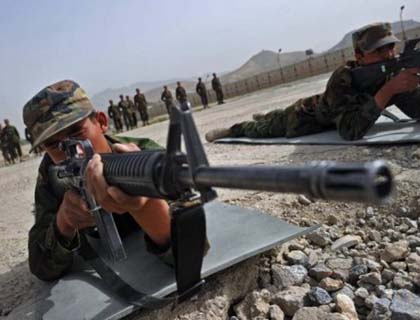The Headlines of domestic print and electronic Media are dominated by security transition process and its political and military consequences. Under the process, the responsibilities of several areas have been already handed over to Afghan security forces, like Bamiyan Province, Mehtarlam, the center Laghaman Province, Lashkargah, the center of one of the most unstable and restive provinces, Helmand, Herat city and Mazar-e-Sharif. The city of Kabul and Panchsher Province are also next in the list to be taken over by Afghan security forces.
Here everybody writes and talks about possible scenario after the completion of security transition process, and what would be the reaction of international community if the initiative of President Hameed Karzia finally comes into a standstill. However, there are people who are optimistic about the process, but generally people are pessimistic and worried about future though Kabul top officials, including President Karzia, try to relieve civilians and meet their worries
The entire security transition process is based on two principles: (1) presumption of success of President Karzia's Peace Initiative and (2) accelerating diminishing of war popularity among militarily involved countries. These two factors are the engine of the current security transition process. Years of involvement in the battlefield has proved too costly of men and money for NATO as well as for the United States.
They have been fighting with Taliban-led militants, but by each passing year, the situation did not improve but deteriorated. Putting a glimpse on the profile of anti-insurgency struggle since 2001, what can be observed do not actually show the realization of objectives of Afghan government or any glittering success of foreign forces in the country. Unfortunately, violence and bloodsheds have hit the height and Taliban militants have proved their shadowy presence, not only in restive areas, but also in peaceful regions.
In addition, the intensification of Taliban attacks and increasing violence in the country have enlarged loss and casualties of foreign forces, which were completely effective to make them reassess their military strategies. The consistence of anti-insurgency struggle in the country has strengthened the anti-war front in Europe as well as in US.
The process has mounted pressure on governments to scale down their military engagement or even pull out completely. As seen, many countries have already pulled out and transferred the security responsibilities to American forces, like Canada, Dutch and etc. other countries that still remain active on the ground, seemingly, are exhausted by the current state as well as the prospective of the struggle. They see a military deadlock ahead, in which Taliban militants cannot be eliminated, instead continue holding deadly attacks on foreign soldiers. To break the deadlock, they are trying to fuel the so-called "the Afghanization project".
Secondly, it should be noticed that anti-insurgency struggle started when the military budget boxes of many countries were full and they assumingly had resources at disposal to fuel their aircrafts and provide the necessities of arm forces on the ground. But the world was struck with 2008 financial crisis and economic depression, which perplexed countries to increase public spending in order to set the economy back on track.
In this juncture, these countries have been wrangling with huge budget deficit and unprecedented level of unemployment rate. They never assumed that the war in Afghanistan could last for such along time that engulfs their military reserves. According to initial calculation, their military budgets were enough to topple militants and establish a democratic government here. When the initial calculation proved false, the willingness to run an anti-insurgency struggle on the back of a strained economy terribly diminished. That is what happened with many Nato members in Europe. From total 27 NATO members, only few members have taken part visibly, others whether did not send their armies or sent remarkably less in number.
The United States is facing similar challenges. It is tired of its European allies as they do not share challenges equally or even proportionately. The total armies of NATO members, except US, in Afghanistan hardly make one third of total foreign involved forces.
The burden of both Iraq and Afghanistan's have been beard by American taxpayers that also when the sovereign debt is turning like a nightmare and budget deficit is remarkably large. It was not likely that President Obama scaled down US troops amidst prevalent violence and hostility if the country's economy was in a better position. Therefore, one of the main reasons of the ongoing security transition process is not improvement of security situation but the economic challenges facing international community.
The second factor which has fuelled or perhaps fabricated the military withdrawal is definitely the peace process initiated by President Karzia. The notion says that military struggle against Taliban-led militants could not bring peace and security, the thing which Afghanistan and Afghan people needs the most. It is based on the assumption that Afghanistan's mess cannot be sweep by bullets or by further bloodsheds as it was inconvenient solved during history. The modern history of the country shows that political challenges were mostly untangle through force. Whoever had the force could rule the others.
But now the situation differs. Foreign countries cannot deploy their forces for indefinite times till the regional supporters of militants come short of source to finance and equip militants.
The Afghan government also is not equipped with an ideology to fight Taliban to death as militants do. Militants fight to die but Afghan security forces fight to protect people and themselves. This is two different things. Thus, military equipment along with latest technology on one side, and radicalism and fundamentalist ideology on the other, has created a balance between two antagonistic forces. To break the balance, a new policy is must. What Karzia and his circle—now has found larger supporters across the world—maintain is a dialogue and compromise with Taliban leaders to lay down arms. But can the peace process end to peace and stability? It is hard to answer.

